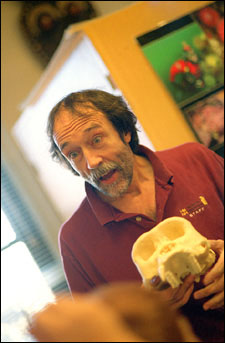Beauty and age on a par at HMNH:
Museum gets a makeover that preserves space’s integrity

The problems started at the door.
Those looking for the Harvard Museum of Natural History (HMNH) entered a nondescript stairwell and had to climb three flights to find what they were looking for.
Not exactly an entryway that trumpeted “Welcome!” for Boston’s only natural history museum.
Those were Joshua Basseches’ first thoughts when he entered the HMNH as the institution’s new executive director four years ago. The bad news was that there was a lot of work to do, from that dismal entry to the often dusty, outdated exhibits spread across 26 Oxford St.’s third floor.
The good news was that the front door was an obvious place to start.
Today the front door still opens onto a stairwell, but flanking that stairwell are skeletons of a saber-toothed cat and a dire wolf – two mammals that though extinct, catch the eye of visitors coming in from the outside. Once past the cat and dog guarding the door, visitors climb a short flight of stairs to a new entry lobby, one of the first changes Basseches made when he took over. Though a bit bare, it provides a much more immediate gateway to the museum two floors up, with dioramas, signs, fliers, and staff on hand to introduce visitors to the institution.
The transformation continues as one climbs the stairs to the museum itself. A new gift shop, a renovated gallery for the museum’s major attraction – the “Glass Flowers” – renovated spaces showcasing exhibits on dinosaur eggs, the gemstone tourmaline, and treasures of Harvard’s 21 million-specimen natural history collection.
The transformation hasn’t been just physical, however. Programming has increased dramatically, with large increases in academic lectures and special programs aimed at children, adults, and families. Basseches said programming has tripled in the past three years with the museum offering almost 900 educational programs in the 2001-02 fiscal year.

Visitors have apparently noticed the change. According to the museum’s statistics, the number of visitors has increased by about 50 percent over the past four years, to 150,000 from 100,000. Making that increase even more remarkable is the fact that it has occurred at a time when visitor numbers to other Boston-area museums has been flat or declining.
Overall attendance from January through August 2002 was down 1 percent for Boston-area museums, a time when the HMNH attendance rose 13.4 percent, according to statistics gathered by Boston’s Museum of Science.
“They’re having growth during a period when no one is, during bad financial times,” said Phillip DeStefano, statistical analyst at the Museum of Science. “Harvard is definitely going against that trend [of declining attendance]. That’s a good thing.”
More changes coming
Today, the Harvard Museum of Natural History stands between museums past and present. Visitors can still stroll through older galleries populated with minerals and stuffed mammals, laid out much as they have been for decades – under glass with limited interpretive and contextual material. Passing through a doorway will take them to a more modern gallery, with more strategic lighting, coloring, and layout, and a host of plaques and cards explaining the exhibit and why it’s important.
Basseches says the transformation is far from over. One of the next galleries likely to undergo renovation is the New England mineral gallery, a small room off the main mineral gallery with exhibits on mining in New England and displays of minerals commonly found in the region. Another coming change will be the installation of a fossil invertebrate exhibit to replace the old exhibit, which was removed when its gallery was renovated.
Though there will likely be continued renovations after that, Basseches said there is a strong sentiment that the changes the museum is undergoing should not constitute a total overhaul. Renovations should be tempered with an appreciation of the historical significance of the museum as it has existed and, at least for some of the galleries, should tread lightly and preserve as much of the original as possible.
Last year, for example, the “Glass Flowers” gallery was closed and gently renovated – better climate control and new lighting and interpretive material were added, while the original specimen cases were carefully cleaned and reinstalled.
There’s a lot of bustle in the newly renovated gift shop in the still-being-renovated Museum of Natural History. According to the museum’s statistics, the number of visitors has increased by about 50 percent over the past four years – to 150,000 from 100,000.
Another gallery certain to receive similar care and reverence is the Great Hall of Mammals. The two-story hall has specimens of some of the largest mammals on earth, including whales and giraffes. Unlike some of the other older galleries, the Great Hall of the Mammals is large and welcoming. Basseches said it is one of the first museum spaces to open in the country designated specifically for the public and should be preserved as much as possible as is, cleaned, relighted, and perhaps augmented with more explanatory material.
Just how far and how fast the renovations will go have yet to be decided, Basseches said. The museum staff has taken a gallery-by-gallery approach to the museum’s physical transformation but has recently begun a strategic planning process to help guide future changes.
Hand in hand with the physical and programmatic growth has been growth behind the scenes. In the past four years, both the museum’s budget and staff have roughly doubled. Income has increased as well, with the museum’s own activities financing roughly 85 percent of its annual operating budget. Much of the rest is contributed by the HMNH’s parent institutions – the Museum of Comparative Zoology, the Botanical Museum, and the Mineralogical Museum, that merged their public programs in 1995 to form the HMNH – in the form of utilities and other physical resources.
Even with a large amount of growth behind them, Basseches said he expects still more constructive change in the future. The growth in visitor numbers so far has occurred during a recession and despite the slowdown in travel after the Sept. 11 terrorist attacks.
Basseches said visits from people in the Greater Boston area and from school-age children are both up 30 percent. Those are important target audiences, Basseches said, because they’re people with whom the museum can build a relationship and who can return – for new exhibit openings, adult lectures at night, and children’s programs on Saturday – much more readily than out-of-town visitors can. Looking around the country, Basseches finds another source for optimism. Some of the biggest museum attractions in the country are natural history museums – at the Smithsonian in Washington, D.C., and the American Museum of Natural History in New York.
“We are it when it comes to natural history in Boston,” Basseches said.
The common thread in the changes that have occurred stems from the museum’s core strength: the research that goes on behind the scenes.
“What makes this museum and complex such an exciting place is what goes on behind the scenes,” Basseches said. “We’re surrounded by 300 faculty, graduate students, and researchers furthering our understanding of the natural world. We’re also surrounded by 21 million specimens…. What it’s really all about is how to connect the public with the research and collections.”




